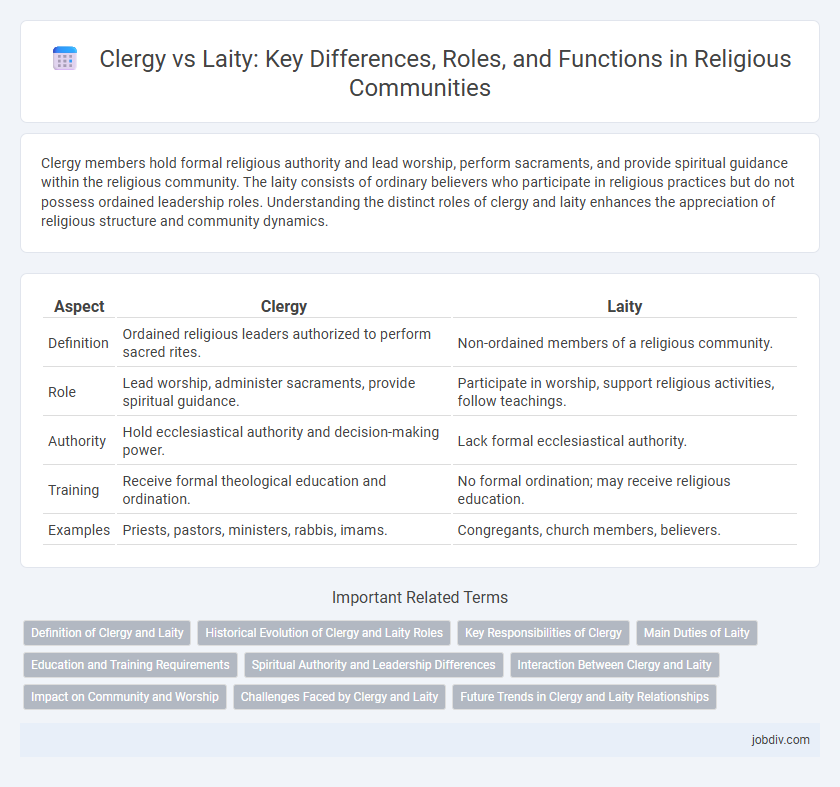Clergy members hold formal religious authority and lead worship, perform sacraments, and provide spiritual guidance within the religious community. The laity consists of ordinary believers who participate in religious practices but do not possess ordained leadership roles. Understanding the distinct roles of clergy and laity enhances the appreciation of religious structure and community dynamics.
Table of Comparison
| Aspect | Clergy | Laity |
|---|---|---|
| Definition | Ordained religious leaders authorized to perform sacred rites. | Non-ordained members of a religious community. |
| Role | Lead worship, administer sacraments, provide spiritual guidance. | Participate in worship, support religious activities, follow teachings. |
| Authority | Hold ecclesiastical authority and decision-making power. | Lack formal ecclesiastical authority. |
| Training | Receive formal theological education and ordination. | No formal ordination; may receive religious education. |
| Examples | Priests, pastors, ministers, rabbis, imams. | Congregants, church members, believers. |
Definition of Clergy and Laity
Clergy refers to individuals who are formally ordained and authorized to conduct religious ceremonies and provide spiritual leadership within a faith community. Laity consists of members who participate in religious life without holding official clerical roles or performing sacramental duties. The distinction emphasizes different roles and responsibilities in religious practice and governance.
Historical Evolution of Clergy and Laity Roles
The historical evolution of clergy and laity roles reveals a gradual differentiation that began in early Christianity, where clergy were distinct as ordained leaders responsible for sacraments and doctrinal teaching, while laity comprised the general congregation involved in worship and community life. Over centuries, the clergy's authority expanded through institutional consolidation, exemplified by the establishment of hierarchical structures such as bishops, priests, and deacons, whereas the laity's role remained more passive but essential for sustaining the church's social and financial frameworks. This evolving division reflects broader shifts in ecclesiastical power, cultural norms, and theological interpretations that continue to influence contemporary religious practice.
Key Responsibilities of Clergy
Clergy serve as spiritual leaders responsible for conducting religious ceremonies, interpreting sacred texts, and providing pastoral care to their congregations. They administer sacraments such as baptism, marriage, and communion, playing a central role in worship practices. Clergy also offer guidance on moral and ethical issues, ensuring that religious teachings are upheld within the community.
Main Duties of Laity
The main duties of the laity include active participation in worship, promoting the teachings of their faith in daily life, and engaging in community service to support the spiritual and social needs of their congregation. Laity members often serve as catechists, administrators, and volunteers, helping to sustain church operations and outreach programs. Their role complements the clergy by fostering a living faith that extends beyond church walls into broader society.
Education and Training Requirements
Clergy members undergo extensive theological education typically involving seminary training, advanced degrees in divinity, and pastoral internships to prepare for religious leadership roles. Laity generally receive informal or community-based religious education without formal certification, focusing on personal faith development and lay ministry participation. The structured academic and spiritual formation required for clergy contrasts with the diverse, often voluntary educational paths embraced by laity.
Spiritual Authority and Leadership Differences
Clergy hold formal spiritual authority through ordination and sacramental roles, guiding religious rituals and doctrinal interpretation. Laity participate actively in community faith but generally lack official leadership or sacramental duties vested in clergy. Differences in authority underscore distinct responsibilities, with clergy leading worship and administering rites while laity support and embody faith in daily life.
Interaction Between Clergy and Laity
The interaction between clergy and laity plays a crucial role in shaping religious communities, fostering spiritual growth, and facilitating effective worship. Clergy provide theological guidance, sacraments, and leadership, while laity contribute through active participation, volunteerism, and lay ministries that support church functions. Collaborative engagement between clergy and laity strengthens communal bonds, encourages shared responsibility, and enhances the overall vitality of religious life.
Impact on Community and Worship
Clergy play a vital role in guiding liturgical practices and providing spiritual leadership, shaping the worship experience and fostering communal unity. Laity contribute actively through participation in rituals, volunteer work, and support of church ministries, enhancing community engagement and social outreach. Together, clergy and laity form a symbiotic relationship that strengthens religious identity and promotes collective faith expression.
Challenges Faced by Clergy and Laity
Clergy face challenges such as maintaining spiritual authority, navigating institutional expectations, and addressing congregational needs while upholding doctrinal integrity. Laity encounter difficulties in actively participating in religious life, balancing faith with secular responsibilities, and seeking meaningful engagement within hierarchical structures. Both groups struggle with communication gaps and evolving roles amidst changing societal values.
Future Trends in Clergy and Laity Relationships
Future trends in clergy and laity relationships emphasize collaborative ministry models, where shared leadership enhances community engagement and spiritual growth. Technological advancements facilitate virtual worship and educational opportunities, expanding laity participation beyond traditional church settings. Increasingly, laity assume active roles in decision-making and pastoral care, reshaping ecclesiastical structures toward inclusivity and mutual empowerment.
Clergy vs Laity Infographic

 jobdiv.com
jobdiv.com